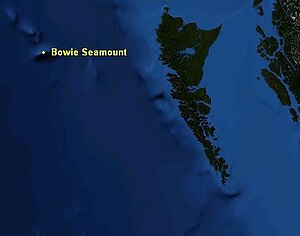Bowie Seamount
| Bowie Seamount | |
|---|---|

Map of Bowie Seamount
|
|

3-D depiction of Bowie Seamount
|
|
| Summit depth | 24 m (79 ft) |
| Height | ~3,000 m (9,843 ft) |
| Location | |
| Location | North Pacific Ocean, 180 km (112 mi) west of the Queen Charlotte Islands |
| Coordinates | 53°18′24.93″N 135°39′33.23″W / 53.3069250°N 135.6592306°WCoordinates: 53°18′24.93″N 135°39′33.23″W / 53.3069250°N 135.6592306°W |
| Country | Canada |
| Geology | |
| Type | Guyot |
| Volcanic arc/chain | Kodiak-Bowie Seamount chain |
| Age of rock | |
| Last eruption | 18,000 years ago |
Bowie Seamount is a large submarine volcano in the northeastern Pacific Ocean, located 180 km (110 mi) west of Haida Gwaii, British Columbia, Canada.
The seamount is named after William Bowie of the Coast & Geodetic Survey.
The volcano has a flat-topped summit (thus making it a guyot) rising about 3,000 m (10,000 ft) above the seabed, to 24 m (79 ft) below sea level. The seamount lies at the southern end of a long underwater volcanic mountain range called the Pratt-Welker or Kodiak-Bowie Seamount chain, stretching from the Aleutian Trench in the north almost to the Queen Charlotte Islands in the south.
Bowie Seamount lies on the Pacific Plate, a large segment of the Earth's surface which moves in a northwestern direction under the Pacific Ocean. Its northern and eastern flanks are surrounded by neighboring submarine volcanoes; Hodgkins Seamount on its northern flank and Graham Seamount on its eastern flank.
Seamounts are volcanic mountains which rise from the seafloor. The unlimited supply of water surrounding these volcanoes can cause them to behave differently from volcanoes on land. The lava emitted in eruptions at Bowie Seamount is made of basalt, a common gray to black or dark brown volcanic rock low in silica content (the lava is mafic). When basaltic lava makes contact with the cold sea water, it may cool very rapidly to form pillow lava, through which the hot lava breaks to form another pillow. Pillow lava is typically fine-grained, due to rapid cooling, with a glassy crust, and has radial jointing.
...
Wikipedia
